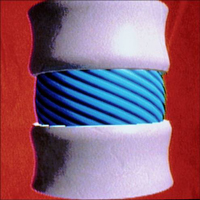Proper movement can help you recover more quickly and can go far in helping you prevent future recurrences of back pain. The most important thing to remember is: Think before you act!
Researcher Nachemson (1) documented the pressures in the spine while standing in various positions. Keep these pressures in mind as you stand. If you must stand in one position for a long period of time, take a break by walking around. Even shifting from one foot to another can increase spinal pressures, so be sure to move around.
100 mm pressure
150 mm pressure
220mm pressure
Mattress: Aaron Chiropractic Clinic recommends a supportive mattress. It doesn't have to be extremely firm. You should be comfortable when resting.
Lying Position:
- Avoid lying on your stomach as that increases spinal disc pressures.
- Lying on your back is best as it keeps intradiscal pressures the lowest (25mm). Turning onto your side triples the pressures (75mm).
- You may find wearing a back brace at night helps. Discuss this at your next appointment with Aaron Chiropractic Clinic.
- When you rise to get out of bed, do basic exercises before you get out of bed!
- After those, carefully and slowly roll onto your side, supporting your weight on your elbow.
- Slip your feet to the floor and straighten your spine at the same time.
- Slowly rise to standing position using your arms and legs to push up.
Note: Your discs take in fluid overnight. So move slowly as your spine adjusts to being upright.
- For every pound you lift with your arms outstretched, you exert 15 pounds of pressure on your spine.
- So consider: If you lift a 100 pound box, you are exerting 1500 pounds of pressure on your low back.
- Therefore, be sure to keep your legs strong and use them whenever you need to do manual lifting.
- Keep the object close to you as you rise to avoid any extra pressure.
When you twist your spine, your discs become like a Chinese finger pull. The more you twist, the more taut they become, the more vulnerable they are to tearing.
- If you must twist, try to do it in a single motion.
- Don't repeat the same motion over and over as in raking your Fort Wayne yard for an hour or forcing the lawn mower to pull-start when it just won't.
- Try not to bend, lift and twist at the same time. That only increases intradiscal pressures more.

Bending stresses your spine as you must tighten all the spinal segments to accommodate the motion.
- Keep your hamstrings well stretched so that they can elongate and take some pressure off your spine.
- If you must bend, use your knees to get lower and closer to the object.
- Keep the object close to you as you rise.
Combination: Bending, Lifting, Twisting
When all three of these motions are combined in a normal spine, let alone a spine that is at risk due to degeneration or other condition, spinal pressures increase and the potential for injury increases. Therefore, think before you act!
- Can I use a dolly to move the box?
- Can I ask my grandkids to take this to the basement?
- Can I get out of the car to get something out of my purse in the backseat?
- Will a neighbor bring my paper from the curb to the front door and hang it on my doorknob for me?
There are always alternatives to getting things done. Aaron Chiropractic Clinic will even help come up with some if you want to brainstorm at your next Fort Wayne chiropractic visit! Though it's true that many back injuries come quickly after the slightest movement, if you think before acting, you may well avoid a spine pain episode that keeps you down in Fort Wayne.
On your next visit to Aaron Chiropractic Clinic, let's discuss some of the movements that tend to start an episode for you. We can find an alternative action together!
"This information and website content is not intended to diagnose, guarantee results, or recommend specific treatment or activity. It is designed to educate and inform only. Please consult your physician for a thorough examination leading to a diagnosis and well-planned treatment strategy. See more details on the
DISCLAIMER page. Content is reviewed by
Dr. James M. Cox I."